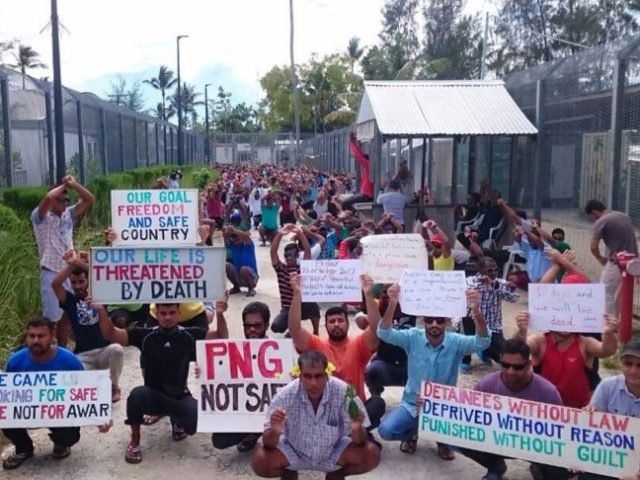This morning’s key headlines from GenerationalDynamics.com
- Australia sends refugees to Taiwan hospitals to keep them from Australian soil
- Once secret refugee deal sends refugees to Taiwan’s hospital
Australia sends refugees to Taiwan hospitals to keep them from Australian soil

The East Lorengau Refugee Transit Center on Manus Island, Papua New Guinea (AP)
The government of Australia recently revealed a previously secret agreement with Taiwan, allowing refugees and asylum seekers in detention but requiring hospitalization to be sent to Taiwan’s hospitals, rather than to Australia’s hospitals.
On July 19, 2013, then-Prime Minister Kevin Rudd signed an agreement with Papua New Guinea (PNG) called “the regional resettlement agreement.” Under this agreement, refugees and asylum seekers arriving by boat without a visa would be sent to Manus Island in PNG, and would have “no chance” of being resettled in Australia as refugees. Another agreement signed with Nauru provided for refugees to be sent to refugee centers there as well.
Last week was the five year anniversary of that agreement. It is estimated that there are almost 800 refugees in the male-only facilities in Papua New Guinea and almost 900 men, women, and children in Nauru.
The policy has been extremely controversial and has been opposed by humanitarian organizations, who claim that the refugee centers in PNG and Nauru are filthy and unsafe, with numerous stories of beatings, torture and sexual abuse.
Despite the objections from activists, the policy has been extremely successful in meeting its objectives. While there had previously been tens of thousands of “boat people” per year arriving in Australia, that number has been reduced to almost none, because refugees know that they will be transferred to one of the offshore detention centers. Australian officials claim that thousands of refugees’ lives have been saved since they did not attempt the risky boat trip with human traffickers.
One of the loopholes in the policy had to do with treating serious illnesses among the refugees. If the refugee or a family member requires hospitalization, then there was no choice but to transfer him to a hospital on Australian soil.
Once on Australian soil, the vast majority have been able to stay indefinitely by preparing applications for High Court injunctions against their return. The court has yet to hear a case, apparently for fear of a ruling that would grant permanent asylum within Australia to a much larger group of asylum seekers. Instead, the government has avoided court cases by granting these refugees bridging visas that permit them to stay without a court case.
However, last month, a 14-year-old girl in a Nauru detention center from Iran who had attempted suicide was moved under court order, along with her family, to a psychiatric hospital in Australia. The case was about to be heard in federal court but, just as proceedings commenced, the Australian government agreed to move her and her family to Australia.
The United Nations human rights agency has repeatedly condemned as arbitrary and illegal Australia’s indefinite detention of refugees. The longest in detention is an Afghan asylum seeker, who has been held in Australian detention centers continuously since 2009. According to Australian human rights lawyer Alison Battisson
“Australia’s policies are against international law and are inhumane,” she said. “In a modern society this practice is unacceptable. Despite numerous opinions and reports from the UN and other human rights bodies, Australia has consistently failed to address arbitrary detention.”
Battison adds: “The Australian government’s lack of response is shameful. It is also insulting to the UN.” Catholic Outlook and AP and Guardian (London)
Once-secret refugee deal sends refugees to Taiwan’s hospital
Last month, it was revealed that, in September of last year, Taiwan and Australia had signed a secret deal to send asylum seekers from Nauru to Taiwan for medical treatment.
According to Taiwan’s foreign minister Joseph Wu, the refugees will receive medical care, and will return to Nauru after recovering, with all expenses paid by Australia’s government:
We are offering our cutting-edge medical technology to help these poor refugees. They are all part of a deal we made with the Australian government.
…
This is something we in Taiwan should be proud of. We are sharing our medical resources with other countries and these unfortunate people.
Under the agreement, Taiwan Adventist Hospital has received ten refugees so far, starting in January. Australia’s Home Affairs Department spokesman said that Taiwan was “consistently ranked as having some of the best hospitals and medical technology in the world.”
Australian officials apparently had been talking to several Pacific countries to make this kind of deal. Taiwan was chosen because of its political predicament – China is a member of the United Nations, but Taiwan is not. Since Taiwan is not a UN member, it is therefore not a signatory to the 1951 Refugee Convention, meaning it is not automatically bound to hear asylum applications. Therefore, the refugees cannot claim protection in Taiwan and can be returned to Nauru. Sydney Morning Herald (22-Jun) and Focus Taiwan (26-Jun) and Lowy Interpreter (Australia)
Related Articles
- A ‘powderkeg’ as Australia closes refugee camp and refugees refuse to leave (31-Oct-2017)
- Australia to send ‘boat people’ to Papua New Guinea (21-Jul-2013)
- Australia will pay $100K each to asylum seekers in Manus Island immigration camp (15-Jun-2017)
- Papua New Guinea Supreme Court bombshell throws Australia’s refugee policy into chaos (30-Apr-2016)
- Hundreds of Australian migrants to be resettled in the United States (11-Nov-2016)
- Trump will honor Australia refugee deal, despite calling it ‘worst deal ever’ (06-Feb-2017)
KEYS: Generational Dynamics, Australia, Taiwan, Papua New Guinea, PNG, Manus Island, Nauru, Kevin Rudd, Joseph Wu, Taiwan Adventist Hospital, Alison Battisson
Permanent web link to this article
Receive daily World View columns by e-mail

COMMENTS
Please let us know if you're having issues with commenting.